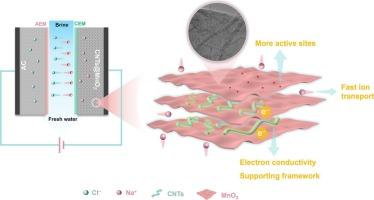Ultrathin MnO2 nanosheets/carbon nanotube heterostructures via electrostatic self-assembly for high-efficiency capacitive deionization
IF 13.2
1区 工程技术
Q1 ENGINEERING, CHEMICAL
引用次数: 0
Abstract
The development of high-performance electrode materials is crucial for enhancing the performance of capacitive deionization (CDI) and advancing its practical application. Among various candidates, manganese dioxide (MnO2) is regarded as a particularly promising electrode material owing to its high theoretical specific capacitance, excellent redox activity, diverse crystal structures, and non-toxicity. However, its practical application is severely limited by insufficient active sites, poor conductivity and structural stability. In this study, we successfully prepared a CNTs@MnO2 composite material with one-dimensional/two-dimensional (1D/2D) heterostructure via a simple and efficient electrostatic self-assembly method. Specifically, the 2D MnO2 nanosheets provide abundant active sites and larger interlayer spacing, significantly enhancing ion storage capacity and transport kinetics. Additionally, the ultrathin 2D structure helps to accommodate the volume expansion of MnO2 during repeated charge-discharge, thereby improving structural stability. The introduction of CNTs not only improves the electrical conductivity of the MnO2 nanosheets, but also offers mechanical support to suppress their restacking, improves the charge transfer efficiency and optimizes the ion diffusion pathways. Furthermore, the electrostatic self-assembly provides the strong interface bonding force between the two materials, promoting a synergistic enhancement effect. Benefiting from the 1D/2D heterostructure design, the CNTs@MnO2 composite material exhibited a outstanding desalination capacity of 51.8 mg g−1 and retained 90.92 % after 50 cycles. Moreover, the ion storage mechanism of the CNTs@MnO2 was revealed through systematic ex situ characterization techniques. This work provides a promising strategy for the rational design and development of MnO2-based electrode materials for CDI.

超薄二氧化锰纳米片/碳纳米管异质结构的静电自组装高效电容去离子
高性能电极材料的开发是提高电容去离子性能和推进其实际应用的关键。在众多候选材料中,二氧化锰(MnO2)因其较高的理论比电容、优异的氧化还原活性、多样的晶体结构和无毒性而被认为是一种特别有前途的电极材料。然而,其实际应用受到活性位点不足、导电性差和结构稳定性差的严重限制。在本研究中,我们通过简单高效的静电自组装方法成功制备了一维/二维(1D/2D)异质结构CNTs@MnO2复合材料。具体来说,二维二氧化锰纳米片提供了丰富的活性位点和更大的层间距,显著提高了离子储存能力和传输动力学。此外,超薄的二维结构有助于适应MnO2在重复充放电过程中的体积膨胀,从而提高结构的稳定性。CNTs的引入不仅提高了MnO2纳米片的导电性,还为抑制其再堆积提供了机械支持,提高了电荷转移效率,优化了离子扩散途径。此外,静电自组装为两种材料之间提供了强大的界面结合力,促进了协同增强效应。得益于1D/2D异质结构设计,CNTs@MnO2复合材料的脱盐能力为51.8 mg g−1,经过50次 循环后,脱盐率为90.92 %。此外,通过系统的非原位表征技术揭示了CNTs@MnO2的离子储存机理。本研究为合理设计和开发二氧化锰基CDI电极材料提供了一种有前途的策略。
本文章由计算机程序翻译,如有差异,请以英文原文为准。
求助全文
约1分钟内获得全文
求助全文
来源期刊

Chemical Engineering Journal
工程技术-工程:化工
CiteScore
21.70
自引率
9.30%
发文量
6781
审稿时长
2.4 months
期刊介绍:
The Chemical Engineering Journal is an international research journal that invites contributions of original and novel fundamental research. It aims to provide an international platform for presenting original fundamental research, interpretative reviews, and discussions on new developments in chemical engineering. The journal welcomes papers that describe novel theory and its practical application, as well as those that demonstrate the transfer of techniques from other disciplines. It also welcomes reports on carefully conducted experimental work that is soundly interpreted. The main focus of the journal is on original and rigorous research results that have broad significance. The Catalysis section within the Chemical Engineering Journal focuses specifically on Experimental and Theoretical studies in the fields of heterogeneous catalysis, molecular catalysis, and biocatalysis. These studies have industrial impact on various sectors such as chemicals, energy, materials, foods, healthcare, and environmental protection.
 求助内容:
求助内容: 应助结果提醒方式:
应助结果提醒方式:


